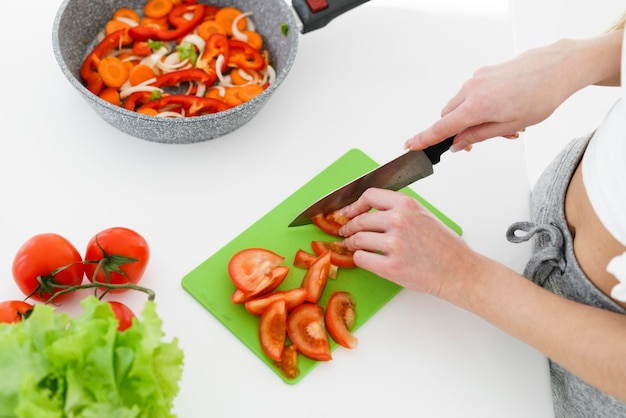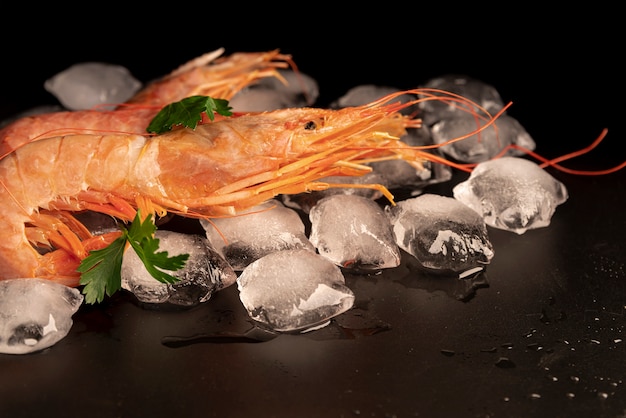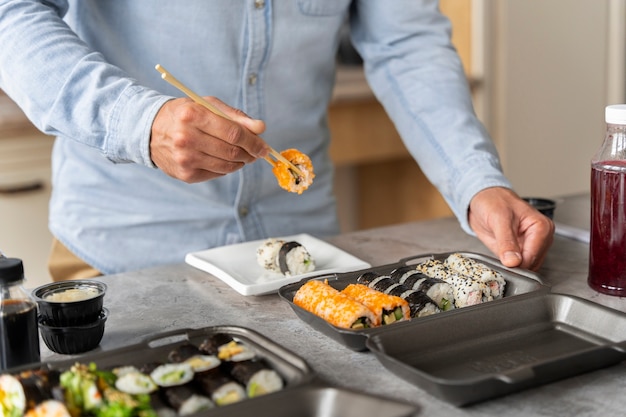(Part 1) Choosing Your Shrimp

The Importance of Freshness
First things first, the most important factor in delicious shrimp is freshness. You've got to choose your shrimp wisely. I always head straight to the fishmonger at the market. You know, those folks with the real expertise who can point you to the freshest catch of the day. They'll tell you what's in season, where it came from, and how it was caught. If you're buying from the supermarket, look for shrimp that are firm to the touch, with a slightly translucent shell and a pleasant, briny smell. Avoid any that smell ammonia-like, as this is a sign of spoilage.types of shrimp
Now, let's talk about varieties. You've got your standard whiteleg shrimp, the most common type you'll find. They're readily available and generally a good choice for a budget-friendly option. Then there's the sweet and delicate pink shrimp, the plump and flavorful tiger shrimp, and even the elusive spot prawn, which is a real treat. You'll find that each type has its own distinct flavour and texture.For example, whiteleg shrimp are known for their mild flavor and delicate texture, while tiger shrimp have a more robust flavor and firmer texture. Pink shrimp, on the other hand, offer a sweet and delicate flavor, and spot prawns are prized for their unique sweetness and tender texture.
Size Matters
Here's a bit of a secret: size definitely matters when it comes to shrimp. For most dishes, medium to large shrimp are ideal, as they cook up nicely and retain moisture. They're also easier to handle and less likely to fall apart during cooking. If you're looking for something a bit more delicate, try using small shrimp, which are perfect for adding a pop of flavor to salads, pasta dishes, or even in a flavorful stock.(Part 2) Prepping Your Shrimp

Deveining: A Necessary Evil
Okay, so we've got our fresh shrimp, now what? You'll often find the "vein" running down the back of the shrimp. This isn't actually a vein, but the digestive tract, which can give your shrimp a slightly bitter flavour. You can easily remove it by making a shallow cut down the back of the shrimp and pulling out the dark line. Don't worry, it's not as messy as it sounds! You can use a sharp knife, kitchen shears, or even a toothpick to do this.Some folks prefer to leave the vein in, believing it adds a bit of earthy flavour. It's really a matter of personal preference. But if you're looking for the cleanest flavour possible, I recommend deveining your shrimp.
Cleaning: A Quick Rinse
Once the shrimp are deveined, give them a quick rinse under cold water to remove any impurities. Be gentle, you don't want to break them. After rinsing, pat them dry with a clean kitchen towel. This will help them cook more evenly and prevent them from sticking to the pan.(Part 3) Cooking Methods: A Masterclass in Shrimp

Pan-Frying: Quick and Delicious
One of my absolute favourite ways to cook shrimp is pan-frying. It's fast, easy, and yields perfectly cooked shrimp every time. Simply heat a tablespoon of olive oil in a non-stick pan over medium-high heat. Add your shrimp in a single layer, making sure they don't overcrowd the pan. Overcrowding the pan will cause the shrimp to steam instead of sear, resulting in a less desirable texture. Cook for 2-3 minutes per side, or until they're pink and opaque. Season with salt, pepper, and a squeeze of lemon juice for a burst of flavour.For a more sophisticated flavour profile, try adding a knob of butter and some fresh herbs to the pan during the last minute of cooking. The butter will add richness and the herbs will provide a fragrant aroma.
Grilling: For a Smoky Flavour
For a smoky, char-grilled flavour, grilling is the way to go. Thread the shrimp onto skewers, leaving a little space between each shrimp to allow for even cooking. Place the skewers on a preheated grill over medium heat and cook for 2-3 minutes per side. Don't forget to oil the grill grates to prevent the shrimp from sticking.You can also add a glaze to the shrimp before grilling for an extra burst of flavor. A simple honey-soy glaze or a chili-lime glaze are great options.
Baking: The Perfect Option for Large Quantities
When I'm cooking for a crowd, baking is a lifesaver. Preheat your oven to 400°F (200°C). Spread the shrimp in a single layer on a baking sheet lined with parchment paper. Bake for 8-10 minutes, or until the shrimp are pink and opaque.For a flavorful twist, try tossing the shrimp with a marinade before baking. A simple lemon-herb marinade or a garlic-ginger marinade will add extra depth to the dish.
Boiling: The Classic Method
Now, let's not forget the classic method: boiling. Bring a large pot of salted water to a boil. Add the shrimp and cook for 2-3 minutes, or until they turn pink and curl up. Remove them from the water with a slotted spoon and serve immediately.Boiled shrimp are great for salads, pasta dishes, or as a simple appetizer. You can also use boiled shrimp to make shrimp stock, which can be used to enhance the flavor of soups, stews, and sauces.
Sautéing: A Versatile Option
Sautéing is another versatile option for shrimp. It's similar to pan-frying but involves using a wider variety of ingredients and flavour profiles. Add a touch of garlic, ginger, or chilli peppers to the pan for a more complex flavour.Sautéed shrimp is perfect for quick weeknight meals. You can pair it with vegetables like broccoli, snap peas, or asparagus for a light and healthy dinner.
(Part 4) Master the Art of Timing
Overcooked Shrimp: A Culinary Crime
One of the biggest mistakes people make when cooking shrimp is overcooking them. Overcooked shrimp become rubbery and dry, and they lose all their delicate flavour. Remember, shrimp only need a few minutes to cook through.The doneness test: A Visual Guide
To know when your shrimp are perfectly cooked, keep an eye on their colour and texture. The shrimp should turn pink and opaque, and they should feel firm to the touch. If you're unsure, check for a little bit of "give" in the flesh. If it feels springy or rubbery, it's overcooked.Undercooked Shrimp: A Health Hazard
On the other hand, undercooked shrimp can be a health hazard. Always cook shrimp until they are completely opaque. You can check for doneness by making a small incision in the thickest part of the shrimp. If the flesh is still translucent, it needs more cooking.(Part 5) Flavour Boosters: The Secret to Delicious Shrimp
Spices: A World of Flavour
When it comes to flavouring shrimp, the possibilities are endless. From classic garlic and pepper to zesty lemon and herb combinations, you can create countless flavour profiles.Here's a few of my favourites:
- Garlic and chilli: A simple yet powerful combination that adds a touch of heat and depth to shrimp. The garlic provides a savory base, while the chili brings a kick of heat. You can adjust the amount of chili depending on your spice tolerance.
- Lemon and dill: A fresh and bright flavour profile that's perfect for summery dishes. The lemon adds a tangy citrus flavor, while the dill provides a delicate herbaceous aroma. This combination is perfect for grilled or pan-fried shrimp.
- Ginger and soy sauce: A classic Asian-inspired flavour that's both sweet and savoury. The ginger adds a spicy warmth, while the soy sauce provides a salty and umami flavour. This combination is perfect for stir-fries, noodles, or as a marinade for baked shrimp.
- Curry powder: A vibrant and aromatic flavour that's perfect for spicy shrimp dishes. Curry powder is a blend of various spices, including turmeric, cumin, coriander, and chili, which all contribute to its complex and flavorful profile. It's perfect for adding a kick to shrimp curries, stir-fries, or even as a rub for grilled shrimp.
Sauces: A Final Touch
Sauces can take your shrimp dish to the next level. From creamy garlic butter to tangy lemon aioli, there's a sauce for every taste.- Creamy Garlic Butter: A classic and comforting sauce that's perfect for pan-fried or baked shrimp. Simply melt butter in a pan with minced garlic and a pinch of salt and pepper. This sauce is simple to make and adds a rich, savory flavor to the shrimp.
- Lemon Aioli: A bright and tangy sauce that's perfect for grilled or sautéed shrimp. Combine mayonnaise, lemon juice, garlic, and a pinch of salt and pepper. The tangy lemon juice cuts through the richness of the mayonnaise, creating a refreshing and flavorful sauce.
- Spicy Chipotle Mayo: A fiery and flavorful sauce that's perfect for shrimp tacos or burritos. Combine mayonnaise, chipotle peppers in adobo sauce, and a touch of lime juice. The chipotle peppers add a smoky and spicy kick, while the lime juice balances the heat with a bright citrus flavor.
(Part 6) Serving Shrimp: A Culinary Art
Shrimp Cocktails: A Classic Starter
Let's talk about serving shrimp. A classic shrimp cocktail is a great starter for any meal. Simply arrange cooked shrimp on a bed of greens, drizzle with your favourite cocktail sauce, and garnish with a lemon wedge.Cocktail sauce is typically a combination of ketchup, horseradish, and Worcestershire sauce, but you can get creative with your own variations. Try adding a touch of hot sauce or a pinch of paprika for a bit of spice.
Shrimp Skewers: A Delightful Appetizer
Shrimp skewers are a delightful appetizer that's perfect for parties or summer gatherings. Thread cooked shrimp onto skewers with your favourite vegetables, such as cherry tomatoes, bell peppers, or onions.Shrimp skewers can be served with a variety of dipping sauces, such as a creamy garlic aioli, a tangy lemon-dill sauce, or a spicy sriracha mayo.
Shrimp Tacos: A Casual Treat
For a casual and delicious meal, try shrimp tacos. Simply warm tortillas and fill them with cooked shrimp, your favourite toppings, such as shredded cabbage, cilantro, and salsa, and a dollop of sour cream or guacamole.Shrimp tacos are a great way to use up leftover cooked shrimp. You can also experiment with different toppings and sauces to create your own unique combinations.
shrimp pasta: A Comforting Meal
Shrimp pasta is a comforting and satisfying meal that's perfect for any occasion. Toss cooked shrimp with your favourite pasta, a creamy sauce, and a sprinkle of Parmesan cheese.You can use a variety of sauces for shrimp pasta, from a classic alfredo sauce to a more flavorful tomato-based sauce. You can also add other ingredients, such as mushrooms, spinach, or sun-dried tomatoes, to enhance the flavor and texture of the dish.
Shrimp Stir-Fry: A Healthy and Delicious Option
Shrimp stir-fry is a healthy and delicious option that's quick and easy to prepare. Combine cooked shrimp with your favourite vegetables, such as broccoli, snap peas, and carrots, in a wok or large pan. Add a touch of soy sauce, ginger, and garlic for a flavourful and satisfying meal.Shrimp stir-fry is a versatile dish that can be adapted to your taste. You can add different vegetables, spices, and sauces to create your own unique variations. You can also serve it with rice, noodles, or even over a bed of greens.
(Part 7) Shrimp: A Culinary Treasure
Nutritional Value
Shrimp are a nutritional powerhouse, packed with protein, omega-3 fatty acids, and vitamins B12 and D. They're also a good source of selenium, zinc, and iodine.Shrimp is a low-calorie, low-fat protein source, making it a great choice for those looking to maintain a healthy weight. The omega-3 fatty acids found in shrimp are beneficial for heart health and brain function. Vitamin B12 is essential for energy production and nerve function, while vitamin D is important for bone health.
sustainable shrimp: Making a Difference
With growing concerns about overfishing, it's important to choose sustainable shrimp. Look for labels like the Marine Stewardship Council (MSC) or the Aquaculture Stewardship Council (ASC), which certify that shrimp are sourced from responsible fisheries or farms.These certifications ensure that shrimp are harvested in a way that minimizes environmental impact and promotes responsible fishing practices. Choosing sustainable shrimp helps to ensure the long-term health of our oceans and the availability of this delicious seafood.
Shrimp and Health: A Balanced Diet
Shrimp can be a part of a healthy diet when consumed in moderation. However, they are relatively high in cholesterol, so it's best to enjoy them as part of a balanced meal.A healthy diet should include a variety of foods from all food groups, including fruits, vegetables, whole grains, lean proteins, and healthy fats. Shrimp can be a part of this balanced diet, but it's important to consume them in moderation and to choose sustainable options whenever possible.
(Part 8) FAQs: Your Shrimp Questions Answered
1. Can I freeze shrimp?
Absolutely! frozen shrimp can be just as good as fresh, if not better. To freeze shrimp, simply place them in a freezer-safe bag and remove as much air as possible before sealing. Shrimp can be frozen for up to 3 months.2. How do I thaw frozen shrimp?
The best way to thaw frozen shrimp is in the refrigerator overnight. You can also thaw them quickly by placing them in a bowl of cold water. Avoid thawing shrimp at room temperature, as this can lead to bacterial growth.3. What's the best way to tell if shrimp is bad?
If shrimp smells fishy or has a slimy texture, it's best to discard it. The shell should also be firm and not discoloured. A fishy smell, especially if it's ammonia-like, indicates that the shrimp has gone bad. If the shrimp feels slimy or the shell is discolored, it's also a sign of spoilage.4. Can I eat shrimp raw?
While some cultures enjoy raw shrimp in dishes like sushi, it's generally not recommended. Raw shrimp can contain harmful bacteria that can cause food poisoning. It's always best to cook shrimp thoroughly before eating.5. How long does cooked shrimp last in the refrigerator?
Cooked shrimp will last in the refrigerator for 3-4 days. Store them in an airtight container in the refrigerator.(Part 9) Final Thoughts: Shrimp Mastery
So, there you have it! My ultimate guide to perfect shrimp, from choosing the freshest shrimp to mastering various cooking techniques. Now, it's your turn to get into the kitchen and try these tips out for yourselves. Remember, cooking shrimp doesn't have to be daunting. With a little practice and these simple tips, you'll be making delicious shrimp dishes in no time!Don't be afraid to experiment with different flavours and cooking methods. Shrimp is a versatile ingredient that can be adapted to a variety of dishes. So, get creative, and enjoy the delicious world of shrimp cooking!
Everyone is watching

Corn on the Cob: The Ultimate Guide to Perfectly Cooked Ears
Healthy MealsAh, corn on the cob. Just the name evokes images of sunny days, barbecues, and that sweet, juicy flavour that ...

Perfect Pork Roast Oven Cooking Time: A Guide to Delicious Results
Healthy MealsThere's something truly satisfying about a perfectly roasted pork. The aroma alone is enough to make your mout...

Scallops: The Ultimate Guide to Perfect Cooking
Healthy MealsAh, scallops. Those delicate, sweet, and utterly delicious morsels of the sea. They hold a special place in my...

Ham Cooking Time: How Long to Bake, Smoke, or Boil a Delicious Ham
Healthy MealsAh, ham. It's a classic, isn't it? A real crowd-pleaser, especially around holidays. And when done right, it'...

Spaghetti Squash: The Ultimate Guide to Cooking and Serving
Healthy MealsRemember that time you saw spaghetti squash at the supermarket, looking all bumpy and strange, and thought, "W...
